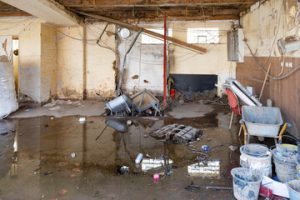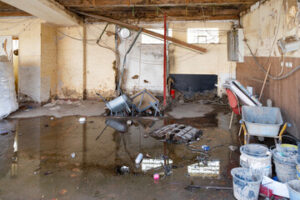Water Damage Salt Lake City UT is a common problem for homeowners and businesses. It can cause structural damage, costly repairs and the growth of mold if not addressed quickly.

Visible signs of water damage include puddles, condensation or a musty smell. Stains on ceilings or walls are another sign of water intrusion that can lead to structural problems if not addressed.
If you’re a homeowner, a sudden and unexplained surge in your water bill can be the first hint of trouble. This might mean that a hidden leak is driving up your expenses and causing structural damage to the home. Untreated, this can lead to costly repairs and significant homeowners insurance claims.
A leaky pipe is a major problem and the primary cause of water damage. Leaks from broken water lines and hoses can cause extensive damage to walls, floors, and furniture in a matter of hours. The good news is that a little preventative maintenance can help reduce the risk of these types of leaks. Inspect your faucets for signs of corrosion, keep gutters clear to ensure that rainwater flows away from the house, and install smart water sensors around appliances and sinks.
These devices will detect water and shut off the water supply before damage occurs, minimizing your expenses and risk. Leaks can also be caused by faulty plumbing, and it’s important to fix any problems right away before they escalate into a bigger issue.
Untreated, the most serious type of water damage can lead to health hazards and expensive home repairs. This type of water damage, often referred to as “black” or “category 3,” contains harmful pathogens and chemicals that can cause severe illness if ingested or inhaled. Categories 2 and 3 water damage typically comes from contaminated sources like sink drainage, tub or shower overflows, and sewer line backups.
Category 3 water damage requires immediate restoration and remediation. This includes disinfecting and sanitizing affected areas. It’s also critical to properly dry out the area before re-entering the home. This process can take three to five days and involves the use of industrial-grade fans and dehumidifiers. This process will minimize the damage and speed up the repair time. In most cases, this type of water damage is covered by insurance policies. However, it’s always a good idea to check with your provider to confirm coverage and to make sure that you have an up-to-date policy.
Floods
Flooding is one of the most common and devastating natural disasters, causing extensive loss of life and property. It’s caused by a variety of events: melting snow and heavy rains in winter or spring; severe thunderstorms with lightning and torrential rain in summer or fall; hurricanes and tropical storms; or a dam or levee failure. Floods are also predicted to become more frequent and intense due to climate change.
When water damage occurs, everything from household items to the very structure of a home can be ruined. Electronics are particularly susceptible to damage from flooding, as the water can seep into components and electrical wiring, resulting in expensive repairs or even complete breakdown. Even appliances like refrigerators, washing machines and dryers can suffer from flooding damage. If you notice signs of water damage, you should immediately turn off and unplug all electronics to prevent any electrical hazards from developing.
Ruined walls are another common sign of water damage in a home or building. When water infiltrates a wall, it can lead to paint peeling and discoloration, as well as weakened structural integrity. The moisture can also cause a buildup of mold in and around the wall, posing a health hazard for the residents.
The floodwaters from these natural disasters are often contaminated with debris, pesticides, fuel and raw sewage, posing a serious health risk to anyone who comes into contact with them. As a result, people who live in areas affected by floods can be at a greater risk of infection from diseases such as typhoid and hepatitis A.
Floods can wreak havoc on multi-family residential buildings as well. Water damage can ruin everything from furniture and fabrics to kitchen equipment, linens, clothing and other personal belongings. It can also affect personal items and documents that are kept in storage or within the walls of the building. In addition, displaced residents may face the emotional trauma of seeing their belongings ruined and having to relocate temporarily. This can make it especially difficult to feel at home in the re-built space, creating stress and frustration that’s hard to recover from.
Mold
Mold is a fungus that needs water and nutrients to grow. It appears in a variety of colors depending on the type of fungus and nutrient source. For example, stachybotrys chartarum (also known as black mold) typically looks dark green or black in color. Other species of mold spores can appear gray, white, yellow or brown. Molds often grow on surfaces like wood, paper, carpet and wallpaper. If mold penetrates porous building materials, it can cause rot and other forms of structural damage.
In addition to being unsightly, a seriously contaminated building is usually unpleasant to inhabit. Inhaling mold spores can lead to health effects, such as respiratory difficulties and irritation of the eyes, nose and throat. People with compromised immune systems — including those who have had organ transplants or cancer treatments — are more susceptible to fungal infections.
It’s important to note that mold growth is typically a secondary result of water damage, rather than the direct cause. For example, a slow leak from a faulty window frame that goes unnoticed for months can eventually saturate drywall, insulation and wooden framing, leading to structural weakening and the creation of an ideal environment for fungal growth.
While it’s important to dry as much of the affected area as possible, safety must always be prioritized. When the situation is safe, shut off electricity to help control electrocution hazards and remove electrical devices from wet areas. It’s also recommended to use a wet/dry vacuum, towels, or mops to remove excess moisture from the area as quickly as possible.
Non-porous materials and items that have been cleaned, such as metals and hard plastics, should be left to dry completely before returning them to service. Porous materials that are moldy should be thrown out or thoroughly decontaminated using a solution of 1 cup chlorine bleach per 1 gallon of water.
Structural Damage
Structural water damage is a serious concern that can compromise the integrity of a home or building. Prolonged exposure to moisture degrades the strength of many materials, including wood and metal. This can lead to rotting, rusting, and deterioration of load-bearing elements like beams and joists. Water can also cause erosion, leading to cracks in foundations and walls. The resulting structural issues can be costly to repair.
In addition to causing structural damage, water damage can also destroy personal belongings and impose health hazards. Valuable items such as furniture, electronics, and art are at risk of being permanently ruined. Oftentimes, these items hold significant sentimental value, or may have been obtained after years of hard work and dedication. Water-damaged possessions can also be at risk of mold growth, which is exacerbated in moist environments.
Signs of structural water damage can include soft or sagging areas of the ceiling and walls, visible signs of mold growth, or a musty odor. These are all indications that moisture is a problem that should be addressed immediately. If left untreated, these problems can escalate and become more severe, resulting in expensive repairs or even complete structural failure of the structure.
If you’re looking to buy a new property, be sure to ask for disclosure of any past incidents of water damage. If a seller has disclosed prior issues, you’ll be able to make an informed purchase decision and prepare financially for the required repairs.
In some cases, insurance coverage for structural water damage is available. However, it’s important to speak with a home or business insurance professional about the specific circumstances before filing an insurance claim.
Structural water damage can be a huge financial burden for any homeowner or business owner. Fortunately, it’s easy to avoid this kind of issue by regularly inspecting your property and taking immediate action when you notice signs of trouble.
